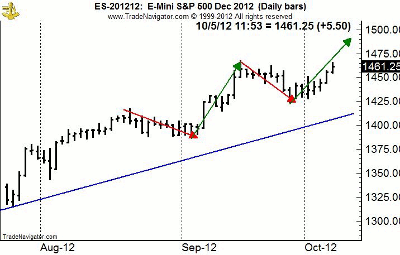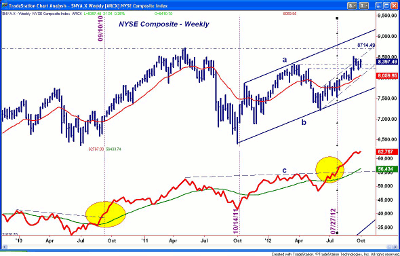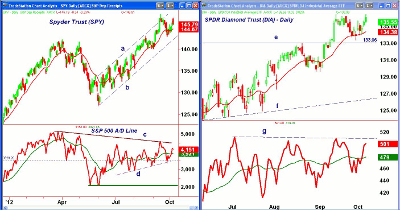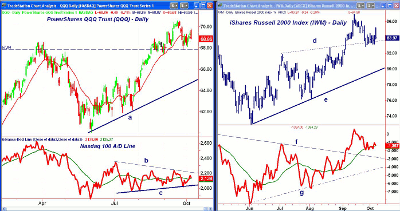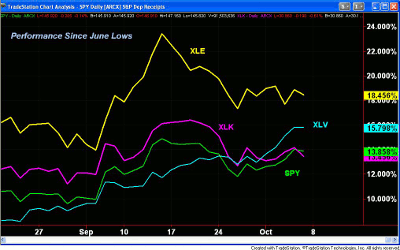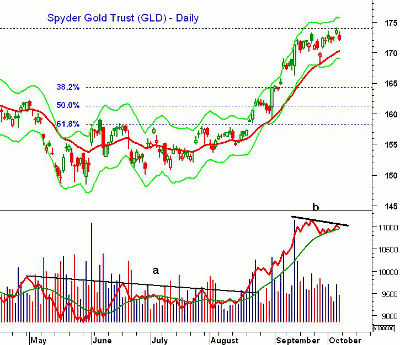A number of experts believe the US is close to a recession if not already in one...but they're having a hard time explaining the technical strength of the market, which often peaks or bottoms well before the economy turns. MoneyShow's Tom Aspray reviews the market here to see which sectors and plays might leave the skeptics behind in coming months.
The market got a nice surprise Friday, as after revisions the unemployment rate dropped below 8% for the first time in three years. The market acted well all week, and by Wednesday's close, the technical action suggested that the correction was over.
Even though the close was mixed-most of the averages closed Friday well below the day's highs-the overall action was constructive.
The decline from the September 14 highs has some nice similarities to the decline from the August 21 highs to the early September lows. In August, the correction lasted 12 trading days, while through Wednesday it had been 14 days since the December S&P 500 E-mini futures had seen their high of 1,468.
If the futures have a an equal rally from last week's lows (67 points), the upside target would be 1,491. This would catch quite a few of the pros by surprise, as many argue that with the Spyder Trust (SPY) already up 16.8% for the year, a 19% gain with this economy would be too much.
Many economists would be even more shocked, as some think we are already in a recession. The debate about the relationship of the stock market to the economy has gone on for many years, and many think that the current stock market strength is an aberration.
The popular belief is that stock prices top out around six months before the start of a recession. Therefore, many can't believe that the current strength in stock prices is forecasting a better economy in the next six months.
Since the market is dominated by professionals and not the public, the skeptics argue that the strength of the stock market can't be trusted. For the investing public, there are many recent events that make this view easy to accept.
The 1973-1975 recessions started in November 1973, but the Dow Industrials topped in March 1973 at 1,067. By the end of November, the index had already lost 23%. By the time the market bottomed in December, it was down over 46%.
Many technical analysts warned that the market was topping well before there were any clear signs of a recession. They were in the minority, as technical analysts in those days had about the same standing as fortune tellers.
Though I was not involved in the market during 1973-1975, I did examine this period closely early in my career, and it convinced me by the early 1980s that technical analysis was the best approach.
NEXT: Applying Technical Analysis to Today's Market
|pagebreak|In the current environment, there are very few analysts that are expecting stocks to still move significantly higher from current levels. However, if you take a look at the weekly chart of the NYSE Composite and its Advance/Decline line, one can make a case that stocks can still move significantly higher.
The chart shows a well defined trading channel (lines a and b) with the upper trend line currently at 9,063, which is 7.6% above current levels. But first, it has to overcome the resistance from the April 2011 high at 8,719.
Below the chart is the weekly NYSE A/D line, which broke through major resistance (line c), on July 27. A similar breakout in September 2010 resulted in a seven-month, 19% rally. A rally that was similar in length and time could take the NYSE Composite to above 9,200 by February.
The weekly A/D line looks ready to make new highs this week, as it is leading prices higher, a very positive sign. Does that mean you should jump into the stock market with both feet?
No. But I bring it up to demonstrate that the potential still exists for stocks to move significantly higher, because many are underinvested in stocks. Long-term readers know that risk, not reward, is my primary consideration when I am making recommendations.
Until the NYSE Composite starts a clear downtrend (lower highs and lower lows), my daily column will continue to look for stocks that I think have significant upside potential and that can be bought with a reasonable amount of risk.
The Eurozone markets were also higher for the week despite more negative data regarding their economies. The concern over the crisis seemed to cool last week, but new protests are likely this week and they could trouble the markets.
The rest of the economic data last week was positive. Early in the week, manufacturing data beat expectations. Orders in the non-manufacturing sector also showed an unexpected surge. Factory orders were weak overall, but if you exclude transportation equipment, they were actually up.
The calendar is quiet this week, with the wholesale trade numbers and the Fed's Beige Book out on Wednesday, followed by the usual jobless claims on Thursday. On Friday, we get the Producer Price Index and the initial reading on consumer sentiment from the University of Michigan.
What to Watch
The technical outlook did improve last
week, as I discussed earlier, and a move above the September highs this week
would further support the bullish case. It would take a drop below the September
26 lows in the major averages to weaken the outlook.
I will be watching the tech sector in particular, as it has a seasonal tendency to perform well in October, as do several other sectors including health care. Some of the retail stocks, like Macy's (M), also appear to have completed their corrections, and these stocks typically do well into the end of the year.
The sentiment picture improved a bit last week, as individual investors became even less bullish: down to 33.8%, from 36.4% the prior week. The financial newsletter writers saw an even bigger change, as the percentage of bulls dropped to 46.8%, down from over 54% two weeks ago. This should be supportive for the market.
The iShares Barclays 20+ Yr Treasury Bond (TLT) gapped lower Friday, but still needs to drop below the September low at $118 to complete a top. It will take a significant drop in the bond market to encourage the many bondholders to move into the stock market.
NEXT: Stocks and Tom's Outlook
|pagebreak|S&P 500
The Spyder Trust (SPY)
gave up its early gains on Friday, but the move above the prior week's high is
consistent with the end of the correction. A move above the prior high at
$148.11 should signal a test of the $150 level, where some selling should be
expected.
The daily chart shows a positive, upward-sloping trading channel (lines a and b). The 20-day EMA was tested on the recent correction, but is now trying to turn up once more. It is currently at $144.74, with additional support at $142.95.
The S&P 500 Advance/Decline line has moved back above its WMA, and is now close to the downtrend (line c) that goes back to the highs it made in the spring. A strong close above this downtrend would be bullish.
There is support for the A/D line now at the uptrend (line d).
Dow Industrials
The SPDR Diamond Trust
(DIA)
gapped higher Friday, coming very close to the September highs at $136.48. For
this week, the Starc+ band is now in the $140 area, which corresponds to
14,000 on the Dow Industrials. A close above this level could get the public's
attention.
The Dow Industrials A/D line shows a pattern of higher lows, and is again close to the resistance (line g) that was formed during the summer. A strong close above this level would be a good sign, yet the relative performance or RS analysis suggests that the big-cap Dow stocks are still lagging the S&P 500.
The first support is at the lows of the past two weeks at $133.64 to $133.94. If broken, it should signal a drop to the $130 to $131 area.
Nasdaq-100
The PowerShares QQQ Trust (QQQ)
opened strong Friday, but ended up lower for the day, which was disappointing.
Apple (AAPL)
was down more than $14, which did not help. The correction in AAPL may be close
to over, and a close back above $676 would be positive.
The key support for QQQ is still at $67.94, which if broken could signal a drop to the $66.50 area. A daily close back above the $70 level will improve the short-term outlook.
The Nasdaq-100 A/D line has moved back above its WMA, but needs to surpass resistance (line b) to improve the outlook. Conversely, a drop below support (line c) would be a sign of weakness.
Russell 2000
The iShares Russell 2000
Index (IWM)
surged in early trading Friday, reaching a high of $85.25 before it turned lower
and closed down slightly for the day. There is still good support now in the
$82.84 to $83.60 area, which was the breakout level (line d).
The Russell 2000 A/D line was very strong in early September, and has just corrected back to its WMA, where it appears to be holding. If the small caps are really going to lead the market higher, the A/D line should start leading prices higher.
NEXT: Sector Focus, Commodities, and Tom's Outlook
|pagebreak|Sector Focus
The iShares Dow Jones
Transportation (IYT)
was the best performer last week, up over 3%, as lower crude-oil prices helped
airline stocks move higher. It is still badly lagging the Dow Industrials, and
needs several strong weekly gains to catch up.
The other standout
performers were the Select Sector SPDR Health Care (XLV)
and the Select Sector SPDR Financials (XLF),
as both were up well over 2%.
The Select Sector SPDR Industrials (XLI), Select Sector SPDR Consumer Discretionary (XLP), and Select Sector SPDR Consumer Staples (XLY) also did pretty well, as they were all up over 1.5% for the week.
The Select Sector SPDR Technology (XLK) and the Select Sector SPDR Energy (XLE) were the two laggards. They were pretty flat for the week. The Percent Change chart above reflects the performance of these two sectors plus the Select Sector SPDR Health Care (XLV) since the June lows.
Even though crude-oil prices have been generally soft, XLE has done the best-up 18%-followed by the 15.8% gain in the XLV. It is interesting to note that XLV moved above XLK in late September, signaling that it was ready to outperform XLK.
Crude Oil
The December crude-oil contract was hit hard in
the middle of the last week, dropping close to the $88 level before it rebounded
Thursday. Prices were once again soft on Friday, as oil closed the week down
more than $2 per barrel. The key 61.8% support is at $87.40, so this week could
be important.
Precious Metals
The SPDR Gold Trust (GLD)
made new rally highs last week, but was lower Friday. The daily OBV did form a
slight negative divergence (line b) last week, suggesting that a short-term top
may be in place.
As I noted in late September's "Buying Gold When Bulls Are Charging," the bullish camp was getting quite crowded, which increased the risk on the long side.
We could just get another pullback to the $167 to $169 level, but one can not rule out a drop back to the 38.2% support just above $164. Clearly now is not the time to be buying, and those who are not long should cancel any open buy orders and wait until we see signs that the rally is ready to resume.
The iShares Silver Trust (SLV) could be even more vulnerable, as it has short-term weekly support at $32.70. There are likely stops under this level that if hit could cause a downdraft. However, there should be a good entry point in SLV in the next month.
The Week Ahead
Though the mixed close Friday was a bit
disappointing, the technical outlook for the intermediate term still looks
positive. There are quite a few stocks that appear to have completed their
corrections last week, but other stocks still look weak, so one needs to be
selective.
Buying stocks that have positive weekly and monthly trends and that have pulled back to chart and retracement support still looks to be a good strategy. For those who are not invested in stocks, the Select Spyder ETFs may be a better alternative.
I have tended to recommend positions in these ETFs and then stick with them until their trends change, but this does not help those who did not buy originally. This week in my sector review, I will give some new entry suggestions for those who are not already long these sector ETFs.
- And don't forget to read Tom's latest Trading Lesson, October's Top Seasonal Sectors

